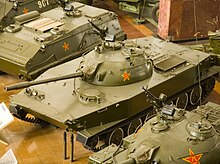
The Norinco Type 63 (Chinese: 63式; pinyin: Liùsān shì) is a Chinese amphibious light tank. First fielded in 1963, it is in many ways similar to the earlier Soviet PT-76. However, contrary to the popular belief, it does have some essential differences from the PT-76 in the vehicle's waterjet propulsion system, etc. It is also known under its industrial designation, the WZ-211.
== Development history ==
The Chinese obtained a few PT-76 amphibious light tanks from the Soviet Union in the mid-1950s. In October 1958, the PLA decided to develop an indigenous amphibious tank based on the PT-76 design...